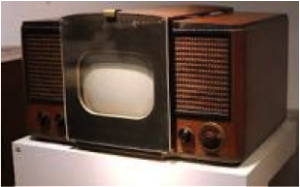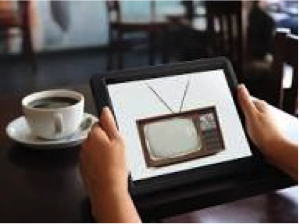 by Vicki MacLeod
by Vicki MacLeod
Secretary-General, GTWN
The reports of my death have been greatly exaggerated 1.
2016 will be the year where watching TV where you want it, when you want it and on whichever device you want it goes mainstream and mass market, thanks to over-the-top (OTT) services and the market response from traditional players.
 Since its invention, television has gone through a number of stages, with ever increasing rapidity, (from monochrome, to colour, to time-shifting through video recorders, to widescreen, to digital, to HD to 3D) that have radically changed the way viewers consume broadcast content. In recent times, despite these rapid developments, many in the tech sector have asked how TV can still be relevant in a tablet and smartphone age. Well, although the “one family TV in the living room” may indeed have reached its use-by date, we are about to enter a new era, where TV will finally become true tele-vision2 to be viewed by anyone, anytime and anywhere.
Since its invention, television has gone through a number of stages, with ever increasing rapidity, (from monochrome, to colour, to time-shifting through video recorders, to widescreen, to digital, to HD to 3D) that have radically changed the way viewers consume broadcast content. In recent times, despite these rapid developments, many in the tech sector have asked how TV can still be relevant in a tablet and smartphone age. Well, although the “one family TV in the living room” may indeed have reached its use-by date, we are about to enter a new era, where TV will finally become true tele-vision2 to be viewed by anyone, anytime and anywhere.
The change is being driven by the young. Children under five are watching about 2.6 hours of TV a day, accessing on-demand content through tablets and other devices3. Their older siblings, five- to 15-year-olds, (sometimes now referred to as “screenagers”) are spending more of their time online than watching live TV. They are place-shifting their content, watching TV online through devices at a time that suits them. This year will see the next stage in the evolution of TV – the continued rise of on-demand and the launch of new services4 which allow all television to be place-shifted.
2016 will be the year of TV anywhere, as Sky Q and its peers and rivals around the world will likely bring place-shifting to the mass market, beyond the tech savvy. At first, this may not look like a big deal. We know from personal experience that TV viewing time has already become very fragmented—the result of overly busy lives that see viewers recording programs that other commitments forced them to miss. Everyone knows that “screen time” today is shared with laptops, phones and tablets, often all at the same time. And coupled with the widespread availability of high-speed wireless Internet, and the influence of social media, today’s viewing experience is more interactive, more consumable and far more sharable in real time.
 What is different now, is that users will be able to place shift their content at will. Everyone will take their TV with them, downloaded or streamed to tablets and smartphones, place-shifting content including recordings from their satellite box. Other place shifting devices, including BBC’s iPlayer, or Australia’s FoxteliQ2 and others also do a similar job in a less sophisticated fashion, meaning that almost anyone will be able to consume content (both free-to-air and subscription) on their own terms.
What is different now, is that users will be able to place shift their content at will. Everyone will take their TV with them, downloaded or streamed to tablets and smartphones, place-shifting content including recordings from their satellite box. Other place shifting devices, including BBC’s iPlayer, or Australia’s FoxteliQ2 and others also do a similar job in a less sophisticated fashion, meaning that almost anyone will be able to consume content (both free-to-air and subscription) on their own terms.
Like time-shifting before it, place-shifting is an important evolution of the television experience and crucial for it to stay relevant in the on-demand era, when competing with so many other instant forms of entertainment. Take, for instance, the pressure the cable companies are facing from so-called over-the-top (OTT) providers, such as Netflix and Hulu, which send their content through the Internet. In short, we’re now seeing the collapse of the walls that previously excluded new entrants to the TV business.
But the regional content licensing agreements of movie and television studios remain the biggest obstacle to the next wave of place shifting – where content will be available globally, in real time, to anyone around the globe. This will be the ultimate in time and place shifting, but it must wait until the content rights holders, like the music industry rights holders, can sort out new business models.
Responding to concerns of content owners about the use of VPN technology to get around their regional controls, Netflix has recently announced that those using proxies and unblockers6 will only be able to access the service in the country where they currently are. Netflix also announced that its service is now available in an additional 130 countries, bringing the total to 190. But, thanks to geographical licensing restrictions, the content being made available to Netflix customers in Canada, for example, will still look dramatically different to the catalogue available to subscribers in Germany or Australia. This move by Netflix comes despite the statement at the January 2016 Consumer Electronics Show (CES) in Las Vegas, Netflix chief product officer, Neil Hunt, acknowledged the futility of trying to limit the use of proxies:
“Since the goal of the proxy guys is to hide the source it’s not obvious how to make that work well. It’s likely to always be a cat-and-mouse game. [We] continue to rely on blacklists of VPN exit points maintained by companies that make it their job. Once [VPN providers] are on the blacklist, it’s trivial for them to move to a new IP address and evade.7 “
So the longer term answer is clearly to negotiate global licensing agreements. According to Hunt, Netflix’s “ambition is to do global licensing and global originals, so that over maybe the next five, 10, 20 years, it’ll become more and more similar until it’s not different”…”We don’t buy only for Canada; we’re looking … for all territories; buying a singular territory is not very interesting anymore.”...“When we have global rights, there’s a significant reduction in piracy pressure on that content. If a major title goes out in the U.S. but not in Europe, it’s definitely pirated in Europe, much more than it is if it’s released simultaneously.”
Finder8 has released a breakdown and map of what percentage of the US catalogue is available in what country. The data clearly demonstrate just how fractured Netflix content availability is around the world, and is sure to provide added momentum to the call for global, real time availability of content. Perhaps then the true promise of television – to overcome time and space barriers – will be fulfilled.
—
1American author, Mark Twain, the pen name of Samuel Clemens.
2The word television comes from Ancient Greek τῆλε (tèle), meaning “far”, and Latin visio, meaning “sight”.
3http://www.theguardian.com/society/2015/ sep/16/survey-records-rise-in-under-fives-watching-tv-and-using-tablets
4Such as SkyQ in the UK, which will allow you to watch programs on 3 TVs and 2 tablets at once, or record 4 programs simultaneously.
5Place shifting actually started with devices such as the Slingbox in 2005, which allowed users to watch TV streamed from their homes anywhere they have an internet connection.
6Unblockers are tools that allow a customer in one geographic regions to access content from the US library, bypassing restrictions, put in place by content licensing agreements.
7h t t p s : // w w w . t e c h d i r t . c o m / articles/20160112/04573333303/netflix-pretends-it-will-crackdown-vpns-just-days-after-admitting-futile-to-do-so
8http://www.finder.com/global-netflix-library-totals.
Vicki MacLeod is owner and principal of her own digital technology and innovation consulting company. She is also on the Board of Directors of OWNSAT (Oceania Women’s Network Satellite Pty Ltd), a Singapore-based satellite investment arm. She has also been Secretary-General of the Global Telecom Women’s Network (GTWN) since 1998. In addition, she is Senior Advisor, Global Strategy for UK based digital media consultancy, Perfect Limited. Vicki has had a considerable career in the telecommunications industry. Most recently she was Senior Advisory, Innovation Culture at the Chief Technology Office (CTO) of Telstra. She previously represented Telstra at the OECD’s Business and Industry Advisory Committee (BIAC) for more than a decade. She is a former Executive Director of the London-based International Institute of Communications (IIC).



